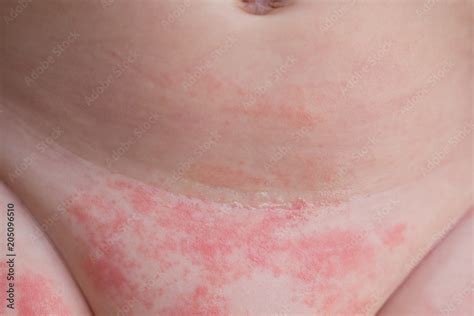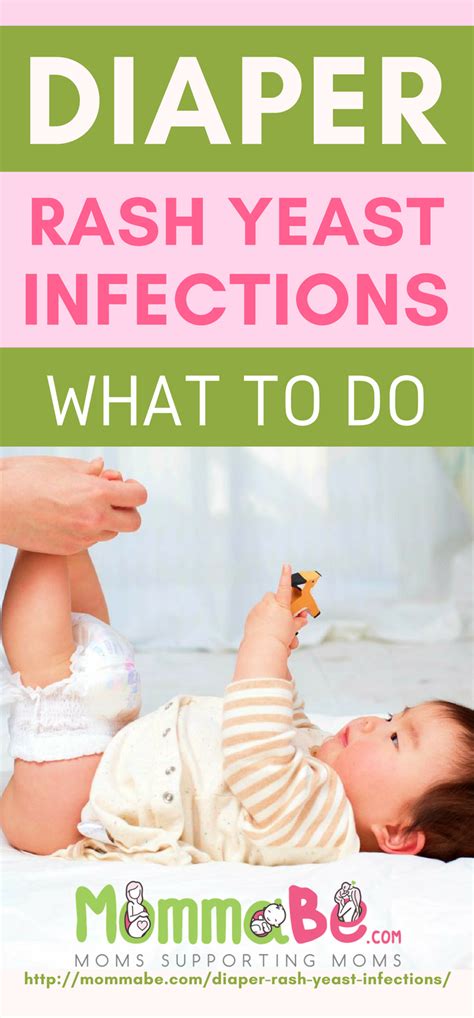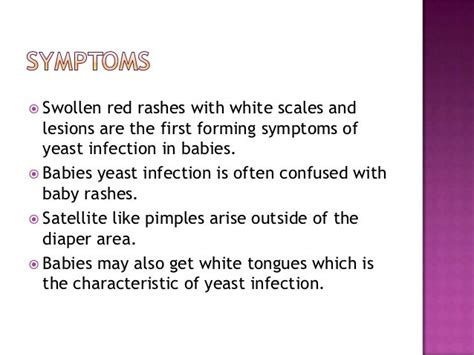Intro
Identify infant yeast infection symptoms, including thrush, diaper rash, and oral candidiasis, and learn about treatment options and prevention methods for newborns and babies, recognizing signs of fungal infections early.
Infant yeast infections, also known as candidiasis, are a common fungal infection that can affect babies. This type of infection is usually caused by an overgrowth of the Candida fungus, which is naturally present on the skin and in the mouth, throat, and digestive tract of infants. Yeast infections can occur in various parts of the body, including the mouth, diaper area, and skin folds. It is essential for parents and caregivers to recognize the symptoms of infant yeast infections to provide prompt treatment and prevent complications.
Infant yeast infections can be distressing for both the baby and the parents. The infection can cause discomfort, pain, and irritation, leading to fussiness, crying, and difficulty sleeping. In severe cases, yeast infections can also lead to more serious health issues, such as sepsis or meningitis. Therefore, it is crucial to be aware of the symptoms and seek medical attention if they persist or worsen over time. By understanding the causes, symptoms, and treatment options for infant yeast infections, parents can take proactive steps to prevent and manage these infections, ensuring their baby's health and well-being.
The symptoms of infant yeast infections can vary depending on the location and severity of the infection. In the mouth, yeast infections can cause white patches on the tongue, gums, and inside of the cheeks. In the diaper area, yeast infections can cause a red, rash-like skin irritation, often accompanied by small, pus-filled bumps. On the skin, yeast infections can cause a rash, itching, and redness, particularly in skin folds such as the neck, armpits, and groin area. Recognizing these symptoms is critical for early diagnosis and treatment, which can help alleviate the discomfort and prevent the infection from spreading.
Types of Infant Yeast Infections

Causes of Infant Yeast Infections
Infant yeast infections are usually caused by an overgrowth of the Candida fungus, which is naturally present on the skin and in the mouth, throat, and digestive tract of infants. Several factors can contribute to the development of yeast infections, including a weakened immune system, antibiotics, and poor hygiene. Babies who are born prematurely or have a low birth weight are also more susceptible to yeast infections. Additionally, babies who are breastfed by mothers who have a yeast infection or are taking antibiotics may also be at risk of developing a yeast infection.Symptoms of Infant Yeast Infections

Treatment Options for Infant Yeast Infections
Treatment for infant yeast infections depends on the location and severity of the infection. For oral thrush, treatment typically involves antifungal medication, such as nystatin or fluconazole, which is applied directly to the affected area. For diaper rash, treatment typically involves applying an antifungal cream or ointment, such as clotrimazole or miconazole, to the affected area. For skin fold infections, treatment typically involves applying an antifungal cream or ointment to the affected area and keeping the area clean and dry.Prevention of Infant Yeast Infections

Complications of Infant Yeast Infections
If left untreated, infant yeast infections can lead to complications, such as sepsis or meningitis. Sepsis is a life-threatening condition that occurs when the infection spreads to the bloodstream, while meningitis is a serious infection that affects the membranes surrounding the brain and spinal cord. Additionally, yeast infections can also cause discomfort, pain, and irritation, leading to fussiness, crying, and difficulty sleeping.Diagnosis of Infant Yeast Infections

Home Remedies for Infant Yeast Infections
While antifungal medications are typically effective in treating infant yeast infections, there are also some home remedies that can help alleviate symptoms and support treatment. Here are some home remedies that may be helpful: * Apply a warm compress to the affected area to reduce discomfort and promote healing * Use a vinegar bath to help balance the pH of the skin and reduce the growth of the Candida fungus * Apply a topical cream or ointment, such as coconut oil or tea tree oil, to the affected area to help soothe and calm the skin * Keep the baby's skin folds clean and dry to prevent the growth of the Candida fungusWhen to Seek Medical Attention

Conclusion and Next Steps
Infant yeast infections are a common and treatable condition that can cause discomfort, pain, and irritation in babies. By recognizing the symptoms, understanding the causes, and seeking medical attention, parents can help prevent and manage these infections, ensuring their baby's health and well-being. If you have any concerns or questions about infant yeast infections, it is essential to consult with a healthcare provider for personalized advice and guidance.What are the common symptoms of infant yeast infections?
+Common symptoms of infant yeast infections include white patches on the tongue, gums, and inside of the cheeks, red, rash-like skin irritation in the diaper area, and rash, itching, and redness in skin folds.
How can I prevent infant yeast infections?
+To prevent infant yeast infections, keep the diaper area clean and dry, change diapers frequently, use a barrier cream or ointment to protect the skin, and avoid using antibiotics unless necessary.
What are the complications of untreated infant yeast infections?
+Untreated infant yeast infections can lead to complications, such as sepsis or meningitis, which can be life-threatening. Additionally, yeast infections can also cause discomfort, pain, and irritation, leading to fussiness, crying, and difficulty sleeping.
We hope this article has provided you with a comprehensive understanding of infant yeast infections, including their symptoms, causes, treatment options, and prevention strategies. If you have any further questions or concerns, please do not hesitate to reach out to a healthcare provider for personalized advice and guidance. Remember to always prioritize your baby's health and well-being, and seek medical attention if you suspect a yeast infection or any other condition that may be causing discomfort or distress. By working together, we can help ensure that our babies receive the best possible care and attention, and thrive in their early years and beyond.
